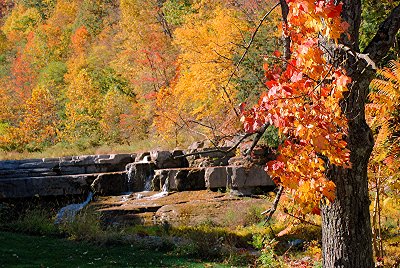- By Dan Veaner
- Around Town
 Print
Print  The New York State Department of Economic Development maintains a section of their Web site just to keep you up to date on fall foliage. The site offers a leaf guide, a foliage forecast, scenic views, and a schedule of Fall events across the state. Foliage reached its peak in our area last weekend, but there are still brilliant reds, oranges, and yellows to be seen here in Lansing.
The New York State Department of Economic Development maintains a section of their Web site just to keep you up to date on fall foliage. The site offers a leaf guide, a foliage forecast, scenic views, and a schedule of Fall events across the state. Foliage reached its peak in our area last weekend, but there are still brilliant reds, oranges, and yellows to be seen here in Lansing.The site uses 'Leaf Peepers,' people around the state who send up to date reports on how the leaves are turning as the season goes forward. The leaf guide shows you what to look for frm yellow bitternut hickory, slippery elm, and American mountain ash leaves, to brilliant orange American sycamore,and Northern red oak, to red leaves from the white ash and flowering dogwood. Some are multi-colored, like the black cherry and sugar maple trees, which turn red and yellow.

When cold weather begins trees stop producing chlorophyll, which is responsible for their green color. Carotenoids (orange and yellow pigments) and anthocyanins (red) that are overwhelmed by green during the summer, shine through as the chlorophyll responds to the cold and the green begins to fade. Leaves may also turn red before Autumn if a tree develops a fungus.

Moisture and temperature determine how stunning a foliage season will be. Warm sunny days paired with cool, but above freezing, nights are the most advantageous conditions for stunning color displays. That certainly describes this year's Lansing autumn.
Photos by Grey Larison
----v4i41



